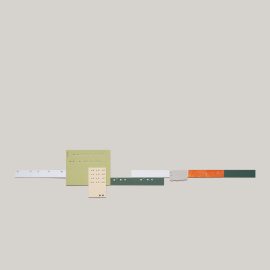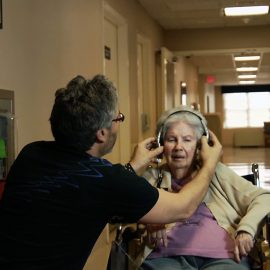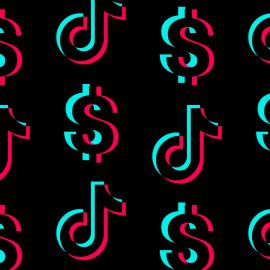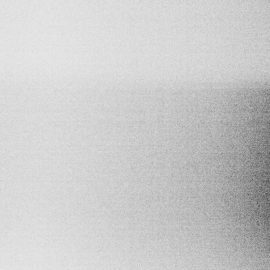I have to admit – I have trouble connecting with digital music these days. The sheer abundance of streaming platforms, the availability of full label catalogs behind the click of the button, not to mention a near-instant ability to share the latest bedroom producer’s output via innumerable social networks and hosting services makes me feel a bit disconnected from the act of true listening and appreciation of their creation, for one reason or another. So I take out a record, open a jewel case, or insert a cassette. The tactile experience of holding the object, interacting with the physical media, and its unique presence in my tangible being somehow makes this one event real. The attachment of memories in acquiring this particular object triggers a moment and brings back that time.
But can we appreciate digital media beyond its ability to seamlessly replicate? Can we reproduce that physical experience and not get overwhelmed by the pile of bits? Is it possible to admire, and, dare I say fall in love with digital music again? In this article, I set out and try and create personal guidelines, restraints, and artificial limitations that seem to work out for me to get to that place. This is not about an audiophile listening setup, and it’s not about digital hoarding. It’s about appreciating the medium from a musical connoisseur’s point of view. It may be a futile exercise, but then it’s no less foolish than owning an NFT.
… on format
I’m not going to go into an in-depth discussion between lossless and compressed audio formats or argue whether one can even tell the difference between a 320kbps or higher bitrates. That’s not my aim here. But remember those artificial limitations that I mentioned above? They’re important when it comes to reaping that one-of-a-kind experience. That super expensive bottle of Scotch I have on my shelf is not exactly the best – it’s just rare. So, I say, raise the bar high. Make yourself venture far to obtain that scarce virtual commodity and be proud of your acquisition. If you simply stick to 320kbps MP3s, then you might as well subscribe to Spotify and be lost in the ocean of its offering once again. Your final product here may still be fungible, but at least it will be something you’ve sourced.
The most obvious choice for digital media is the 24-bit WAV format. Again, 16-bit would be just fine – trust me on that – but if you can, why not go for the top? So you must proclaim to yourself – “my collection will only contain high-resolution lossless music in WAV” and then you must stick to it. To be perfectly honest, FLAC (a lossless codec) is another viable alternative here, if you want to save space (which could become expensive). On Bandcamp, you should be able to download FLACs and WAVs (as well as AIFF, which is another lossless format), and some sites like HDtracks, Qobuz, and Bleep will provide hi-res files as high as 24-bit/192kHz. Also, most, if not all labels these days, will offer digital download at higher resolution. Since I often receive promos in various formats, my personal bottom line boundary format is FLAC. I delete MP3s.
… on storage
Since your virtual music shelf is digital we need to identify a correct and safe medium for the host. I recommend you invest in a Network Attached Storage (NAS) – a dedicated box that is locked in the closet (or under your desk) which you can get to over your home network from any machine (and OS). Mine is a QNAP device with six hard-drive bays configured with RAID 5 in case any drive fails. I’ve [only] got about 10 TB at the moment, but trust me, that’s plenty of space if you’re just storing music. Some dedicated machines will come with their own hosting and broadcasting software, which means you can set it up to stream the media even via the web or to your mobile phone and even Apple CarPlay. My QNAP has Music Station, but to be honest, I’ve always only played directly in my studio.
Redundant local storage doesn’t mean that your precious collection is safe. You must have a backup. Again, I will not go into a lengthy discussion on the availability of various offline and cloud providers in this article. Suffice it to say that I highly recommend that you sync your collection by using something like Microsoft OneDrive, Google Drive, AWS, or even Dropbox. It doesn’t matter which one, and it doesn’t have to be just for music – so find a plan that works for all of your needs, and finally, splurge. A 2TB plan is the cost of a Netflix subscription. And let’s face it – your digital storage needs are only increasing, so it’s time to finally pay for that peace of mind, and might as well backup all of your music.
but, wait…
By now you’re probably thinking: “This all sounds expensive. Aren’t some digital platforms like Tidal and Amazon [and even Spotify in the near future] already stream lossless music for the fraction of the cost that I will have to pay on all these things mentioned above?” The answer is “yes” – and if you choose to go that route, you are very much welcome. But remember, then I can’t help you create those “artificial constraints” that will make you appreciate all that you’ve personally done for your music collection. And as a result, you will be, once again, overwhelmed with the torrent of sounds available at a click of a button. In fact, I subscribe to all three of the above streaming platforms, but I don’t feel like I really “invest” in that music. I guess you can make playlists to emulate the above. Yes, it all seems rather silly, doesn’t it? But this is an article on setting some guidelines, developing principles, and extracting some pride. I want you to treasure your music collection and not simply pay someone for access to it at will. So if you’re still with me, let’s keep going!
… on organizing
It’s obvious that an extensive collection of any kind needs to be very organized. Actually, hang on, let me rephrase this: you need to be organized. You need to create the directory structure for artists and albums and properly name all the files. You need to tag all these files with Labels, and Dates, and, yes, maybe Genres and possibly even Conductors (if you plan on going the classical music route). And don’t forget to have a high-resolution album cover attached to each file! Thankfully, these you usually get when purchasing the digital files, and if not, the cover art is readily available on the Intarwebs. But, once again, you have to be meticulous about it. Take time in and don’t rush when you “slot your new record on its space on the shelf”.
I recommend that you get [and finally pay for] a good media player and library manager for all of these needs. On PC, I use JRiver which has pretty good drivers for “bit-perfect” streaming of files and lets me organize all of my files with many built-in utilities. On the Mac, I’ve also used Audiorvana and would say that it does the job well. But you can also tag all your files by hand and use a trustworthy VLC player if you don’t want to spend money on software. I don’t mind paying for things that I use every day. Beyond organizing your library, I also recommend that you create some automatic playlists, to keep track of your most recent imports, your top hits, and most importantly, those albums that you have neglected for some years.
… on playing
This is a tricky one. Certainly, you can just hit play here, right? Recall the “ceremony” of opening the vinyl, taking out the 12″ and placing the needle into its grooves. Can you do something like that with the files? I always try my best to play the entire album all the way through. I track the “number of plays” for each file and even rate tracks as I go along. This is where a lot of self-discipline comes in. Try not to add a new album into your collection if you have many albums unplayed. You don’t want this to turn into hoarding. Mindfully listen and just be aware. It could still be a passive listening session [I have Otto A Totland‘s new album playing right now], but I know that I’m listening to it, not streaming through a playlist of random new tracks.
It helps if you can make the album cover clearly visible at all times. Put it on full screen! And how about this one for a crazy idea: why don’t you print out the album covers in your collection as photos which you display? You can even store these photo prints in a shoebox, if you decide, and flip through them at your leisure. I’m sure there are a ton of services out there, but check out these Wood Block photo prints from Snapfish that you can display on your desk while the music is playing. How cool is that? Yes, they may cost you a little, but it’s still cheaper and more convenient than vinyl and now you have something incredibly physical tied to your digital library.
THE PROCESS
To summarize, I want to go over the process again. I want you to respect the method and the system and have you regard it as sacred and grand. I want you to worship and follow the ritual so that you honor the music again. And the musicians and labels and artists. And all of the ones who’ve put effort and time. Something that’s truly worth more than a click of a button. Something that embodies a true relationship in its purity, even if the form of that something is digital. So let us fall in love!
You read the review on this site or another. You find the album. You stream it on Bandcamp, on Spotify, or even Soundcloud. You like what you hear and you want to invest. You purchase the highest available quality. And when you click “buy” you also envision the transfer of currency – something you give back to those that create. These files are precious and must be stored carefully. You place them in your library on a virtual shelf. You label and tag and spend time to classify. You take pride in your pristinely cataloged collection. You cherish the cover art and spend the time admiring it. You read the track titles and think about the words. You sit back and marvel at the labor by all, to bring it to this moment. The countless hours that went into composing and arranging; tweaking and polishing; mixing, and mastering; submitting to labels, agreeing on dates; the pitching and marketing; art and design; this digital package that holds so much love…







